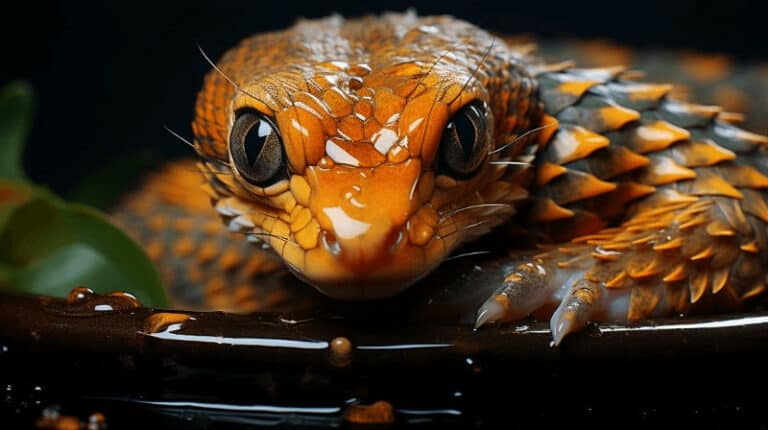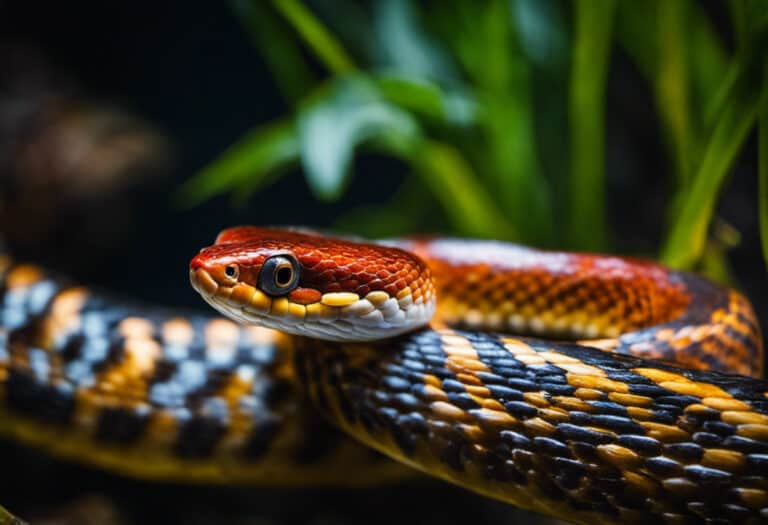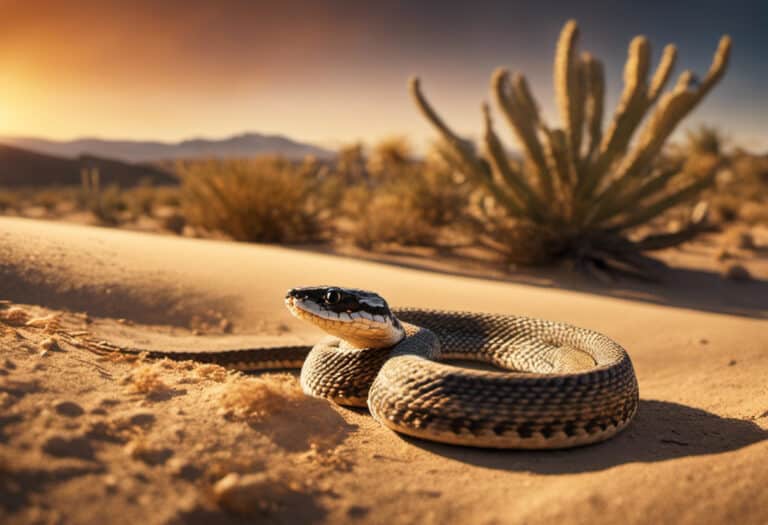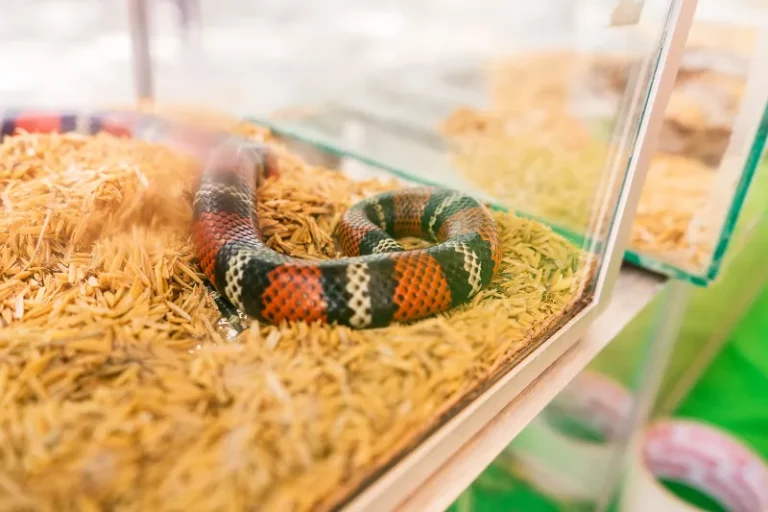9 Snakes That Not Lay Eggs
Are you fascinated by snakes and their unique reproductive methods? If so, get ready to delve into the world of snakes that don’t lay eggs.
In this article, we’ll explore the intriguing phenomenon of live birth in snakes, where mothers give birth to live young instead of laying eggs.
From sea snakes and vipers to water snakes and garter snakes, we’ll uncover the diversity of snake species that exhibit this reproductive strategy.
Join us as we unravel the mysteries of snakes that don’t lay eggs and discover the captivating world of live birth in these fascinating reptiles.
Key Takeaways
- Sea snakes, Rinkhals, Vipers, and Pit Vipers are all live-bearing snakes.
- Water snakes and Garter snakes are ovoviviparous.
- Boa constrictors, Death adders, White-lipped snakes, Anacondas, Amazon Tree Boas, and Rattlesnakes all give live birth.
- Live birth provides better protection for neonates, allows snakes to choose their preferred habitat, and avoids the vulnerability of snake eggs to predators.
1) Sea Snakes, Rinkhals, Vipers, and Pit Vipers
Sea snakes, Rinkhals, Vipers, and Pit Vipers are all live-bearing snakes, which means they give birth to live young instead of laying eggs. These snakes have evolved unique predator avoidance strategies and adaptations to temperature changes.
To avoid predators, they use camouflage, venomous bites, and defensive postures. Some sea snakes have developed flattened tails to aid in swimming and escaping from predators.
In terms of temperature adaptation, these snakes are ectothermic, meaning their body temperature depends on their environment. They can adjust their behavior and seek out warmer or cooler areas to regulate their body temperature. This allows them to thrive in a variety of climates and habitats, from the cold regions of Europe to the hot deserts of Africa.
These adaptations have enabled these live-bearing snakes to survive and reproduce successfully in their respective environments.
2) Water Snakes and Garter Snakes
Water snakes and Garter snakes, being ovoviviparous, give birth to live young due to their habitat in wet areas like ponds and swamps. These snakes have developed unique strategies to survive and thrive in their environment. Here are some key points to consider:
-
Predator avoidance strategies: Water snakes and Garter snakes have evolved various techniques to avoid predators. They use their coloration to blend in with their surroundings, making them difficult to spot. They’re also agile swimmers, allowing them to escape quickly if threatened.
-
Feeding difficulties in newborns: The newborns of water snakes and Garter snakes face challenges when it comes to feeding. They’re born fully formed but small, making it difficult for them to capture and consume prey. However, these snakes have adapted by having a high metabolic rate, enabling them to grow and develop quickly.
-
Freedom to explore: Living in wet areas provides these snakes with the freedom to explore their surroundings. They’ve access to a wide range of food sources and can move between land and water with ease.
-
Independence from their mothers: Once born, the young snakes are independent and don’t rely on their mothers for survival. They immediately start hunting and foraging on their own, developing the necessary skills to survive in their environment.
-
Adaptability to changing conditions: Water snakes and Garter snakes are highly adaptable creatures. They can adjust their behavior and reproductive strategies based on environmental conditions, ensuring their survival and freedom.
Overall, water snakes and Garter snakes have developed remarkable predator avoidance strategies and overcome feeding difficulties in their newborns, allowing them to thrive in their wet habitats. Their ability to adapt and explore freely contributes to their success in the wild.
3) Boa Constrictors and Death Adders
If you’re considering boa constrictors or death adders as pets, it’s important to note that both species give live birth and have different gestation periods.
Boa constrictors have a longer gestation period of 4-5 months, while death adders have a shorter gestation period of unknown duration.
Challenges in neonate survival for live-bearing snakes include difficulty in producing viable offspring, high mortality rate due to predators, lack of food, cold temperatures, and lack of dry land.
However, live-born snakes are capable of survival on their own and don’t require assistance from the mother. Parental care in live-bearing snakes is limited, as most live-bearing snakes don’t provide any care for their offspring.
Despite these challenges, live birth in snakes provides better protection for neonates and allows snakes to choose their preferred habitat.
4) White-lipped Snakes and Anacondas
When considering white-lipped snakes and anacondas as pets, it’s important to note that both species have evolved to give live birth and can provide better protection for their offspring. These snakes have unique adaptations to their environments, allowing them to thrive in their natural habitats.
Here are some key points about white-lipped snakes and anacondas:
-
Adaptation to frigid temperatures: White-lipped snakes have evolved to give birth due to the cold climates they inhabit. They can warm themselves and their embryos in the sun, ensuring the survival of their young.
-
Role of size in predator avoidance strategies: Anacondas, known for their large size, have developed viviparity as a predator avoidance strategy. Their size deters predators from stealing their eggs, providing better protection for their offspring.
With their ability to adapt to extreme temperatures and their size as a defense mechanism, white-lipped snakes and anacondas demonstrate the resilience and freedom of nature’s creations.
5) Amazon Tree Boa and Rattlesnake
The Amazon Tree Boa and Rattlesnake are two species of snakes that give birth to live young. The Amazon Tree Boa has a gestation period of 6-8 months and reaches sexual maturity at three years old.
On the other hand, Rattlesnakes are ovoviviparous, with the embryos developing inside the mother’s body before being born live.
Gestation Period for Boas
Boa constrictors have a gestation period of 4-5 months before giving live birth to their neonates. During this time, the female boa constrictor’s body undergoes significant changes to accommodate the growing embryos.
The gestation period begins after successful mating, once sexually mature female boas can breed and conceive. The female carries the developing embryos internally throughout the gestation period. Boas become sexually mature at around 2-3 years of age. The gestation period lasts for 4-5 months before birth.
These remarkable snakes demonstrate their freedom by choosing their preferred habitat and reproducing in a way that ensures the survival of their young. Boa constrictors exemplify the beauty of nature’s diversity and the fascinating reproductive strategies of different species.
Sexual Maturity in Boas
You may be curious about how long it takes for you to reach sexual maturity as a boa constrictor. Boas are fascinating creatures that have their own unique timeline for reaching this milestone.
Typically, female boas reach sexual maturity around 2 to 3 years of age, while males can reach it as early as 1 to 2 years. However, reaching sexual maturity isn’t solely determined by age. Factors such as size, health, and environmental conditions also play a role.
Once boas reach sexual maturity, they’re able to reproduce and contribute to the survival of their species.
In terms of predator avoidance strategies, boas have evolved a few effective techniques. They’re skilled climbers, using their muscular bodies to navigate through trees and escape potential threats.
They’re also excellent swimmers, allowing them to move swiftly through water bodies to evade danger. Additionally, boas possess excellent camouflage, blending into their surroundings to hide from predators.
These predator avoidance strategies, combined with their ability to reach sexual maturity, make boa constrictors highly adaptable and resilient creatures in the wild.
Embryo Development in Rattlesnakes
As a rattlesnake, your embryos develop inside your body before being born live, a reproductive method known as ovoviviparity. This unique process offers several advantages for your offspring, ensuring their survival in the wild.
Here are five fascinating facts about embryo development in rattlesnakes and predator avoidance strategies in neonates:
-
Neonates have well-developed venom glands and fangs, enabling them to defend themselves against potential predators.
-
Rattlesnake neonates possess a striking pattern and vibrant colors, serving as a warning to predators of their venomous nature.
-
Upon birth, neonates instinctively disperse into the surrounding environment, reducing the likelihood of predation by spreading out.
-
Neonates possess an extraordinary ability to camouflage themselves, blending seamlessly with their surroundings, providing them with a higher chance of survival.
-
Rattlesnake neonates exhibit a unique behavior known as ‘tail rattling,’ which mimics the sound of an adult rattlesnake, effectively deterring potential predators.
Challenges Faced by Neonates in New Environments
As a neonate in a new environment, you face several challenges. Predators pose a constant threat, increasing the mortality rate among newborns.
Additionally, finding food can be difficult, leading to potential starvation.
Lastly, temperature fluctuations in unfamiliar surroundings can be detrimental to your survival.
Predator Avoidance Strategies
When it comes to avoiding predators, live-bearing snakes have developed various strategies to protect their offspring.
These predator avoidance strategies are crucial for the survival of newborn snakes, especially considering the feeding difficulties they often face.
Here are five strategies that live-bearing snakes employ to keep their young safe:
-
Camouflage: Many live-bearing snakes have evolved colors and patterns that blend in with their surroundings, making it harder for predators to spot them.
-
Hiding: Some live-bearing snakes seek refuge in crevices, under rocks, or in dense vegetation to avoid detection by predators.
-
Mimicry: Certain live-bearing snakes mimic the appearance or behavior of venomous species, deterring predators from attacking them.
-
Defensive behaviors: Live-bearing snakes may display defensive behaviors like hissing, puffing up their bodies, or striking to intimidate predators.
-
Parental care: Unlike egg-laying snakes, live-bearing snakes can provide immediate protection and assistance to their newborns, increasing their chances of survival.
These predator avoidance strategies help live-bearing snakes ensure the freedom and safety of their offspring in the challenging world they inhabit.
Feeding Difficulties in Newborns
Feeding difficulties can arise in newborn snakes, and parental care plays a crucial role in overcoming these challenges.
As a newborn snake, you may face difficulties in finding and capturing prey due to your small size and limited mobility. Your parents, however, provide important parental care by selecting appropriate prey items and assisting in the feeding process.
They may catch small prey and present it to you, making it easier for you to consume. Additionally, they may regurgitate partially digested prey, known as ‘brooding,’ which allows you to feed on the already processed food.
This behavior ensures that you receive the essential nutrients needed for your growth and development.
Parental care in terms of feeding difficulties is vital for your survival and success as a newborn snake. By receiving assistance from your parents, you’re better equipped to overcome these challenges and thrive in your environment.
Adaptation to Temperature Changes
You can adapt to temperature changes by utilizing behaviors such as basking in the sun or seeking shelter in cooler areas.
Snakes, like many other animals, have developed various adaptations to cope with temperature fluctuations. These adaptations not only help them regulate their body temperature but also aid in predator avoidance strategies.
Here are some ways snakes adapt to temperature changes:
-
Behavioral Thermoregulation: Snakes actively choose their environment to regulate their body temperature. They may bask in the sun to warm up or seek shelter in cooler areas to cool down.
-
Ectothermy: Snakes are ectothermic, which means their body temperature is influenced by their surroundings. They rely on external heat sources to warm their bodies and maintain optimal functioning.
-
Coloration: Some snake species have color patterns that help them absorb or reflect heat. Dark colors absorb heat more efficiently, while lighter colors reflect heat.
-
Burrowing: Snakes may burrow underground to escape extreme temperatures. Burrows provide a more stable and insulated environment.
-
Torpor: During periods of extreme temperature, snakes may enter a state of torpor, where their metabolic rate slows down, conserving energy and reducing heat loss.
These adaptive behaviors and strategies allow snakes to survive and thrive in different temperature conditions, providing them with the freedom to explore diverse habitats and evade predators.
Live Birth in Snakes and Offspring Independence
Live-born snakes, such as sea snakes, vipers, and pit vipers, are capable of surviving on their own without any assistance from the mother.
This independence is advantageous for newborn snakes as they face various challenges in their new environments. They must employ predator avoidance strategies to ensure their survival and overcome feeding difficulties in their early stages of life.
To illustrate this, consider the following table:
| Challenges Faced by Neonates | Predator Avoidance Strategies | Feeding Difficulties in Newborns |
|---|---|---|
| Difficulty in producing viable offspring | Camouflage and hiding | Small size and inability to catch prey |
| High mortality rate due to predators | Fast movements and agility | Limited hunting skills |
| Lack of food | Mimicry and deception | Inability to locate suitable prey |
| Cold temperatures | Burrowing and seeking shelter | Inability to regulate body temperature |
| Lack of dry land | Climbing and swimming abilities | Difficulty in finding secure hiding spots |
Live birth in snakes allows the offspring to be independent from the moment of birth, which is advantageous in their challenging environments.
They do not require assistance from the mother and can navigate their surroundings on their own. This independence gives them the freedom to explore, hunt, and adapt to their environment without relying on parental care.
Benefits of Live Birth in Snakes
Live birth in snakes offers several advantages over egg-laying, providing a sense of freedom and survival for both the mother and her offspring. Here are the benefits of live birth in snakes:
-
Enhanced predator avoidance strategies: Neonates are born fully developed, allowing them to actively evade potential threats from predators. This gives them a better chance of survival in the wild.
-
Improved feeding abilities in newborns: Live-born snakes are equipped with the necessary instincts and physical attributes to locate and capture prey immediately after birth. This ensures that they can acquire essential nutrients and sustain themselves from the start.
-
Greater maternal protection: Live-bearing snakes, especially those that are large or venomous, can effectively shield their young from potential harm. This added protection increases the chances of offspring survival in their early stages.
-
Efficient thermoregulation: Live-born snakes have the advantage of receiving warmth from their mother’s body, enabling them to maintain optimal body temperature for proper physiological functioning.
-
Flexibility in habitat selection: Unlike eggs, live young aren’t confined to specific nesting sites. This allows live-bearing snakes the freedom to choose their preferred habitat, ensuring their survival in environments that best suit their needs.
These benefits of live birth in snakes contribute to their ability to thrive and adapt in various ecosystems, providing a sense of freedom and resilience in their quest for survival.
Advantages of Live Birth Over Egg-Laying
When it comes to reproduction, live birth offers several advantages over egg-laying for snakes. Live-bearing snakes have developed predator avoidance strategies and overcome feeding difficulties in newborns.
Unlike eggs, live-born snakes aren’t vulnerable to predators that may steal or damage the eggs. This provides better protection for the neonates, increasing their chances of survival.
Additionally, large or venomous snakes can effectively protect their young from potential threats. Live birth also allows snakes to warm their young easily, ensuring their proper development.
Moreover, live-bearing snakes can choose their preferred habitat, avoiding wet conditions that aren’t ideal for eggs.
Overall, live birth in snakes provides numerous benefits, ensuring the successful reproduction and survival of these fascinating creatures.
Frequently Asked Questions
What Are Some Challenges Faced by Neonates in New Environments?
Challenges faced by neonates in new environments include difficulty in producing viable offspring, high mortality rate due to predators, lack of food, cold temperatures, and lack of dry land. They must adapt to survive.
Do Live-Born Snakes Require Assistance From Their Mothers?
No, live-born snakes do not require assistance from their mothers. They are capable of survival on their own. This evolutionary advantage allows snakes to choose their preferred habitat and provides better protection for neonates.
What Are the Benefits of Live Birth in Snakes?
The benefits of live birth in snakes include better protection for neonates, the ability for large or venomous snakes to effectively protect their young, and the ease of warming their young. Live birth also allows snakes to choose their preferred habitat.
What Are the Advantages of Live Birth Over Egg-Laying for Snakes?
Live birth in snakes has advantages over egg-laying. Challenges faced by neonates include predators, food scarcity, and cold temperatures. Live-born snakes require no assistance. Live birth provides better protection, warmth, and allows snakes to choose their preferred habitat.
What Factors Should Be Considered When Choosing a Snake for a Pet or for Breeding?
When choosing a snake for a pet or breeding, consider factors like care requirements, size, appearance, and personality. Challenges may include reproductive issues for oviparous females and longer recovery time for live-bearing females.
Conclusion
So there you’ve it, the incredible world of snakes that don’t lay eggs.
From sea snakes to vipers, water snakes to garter snakes, and boa constrictors to anacondas, these live-bearing species showcase the remarkable diversity of reproductive strategies in snakes.
The challenges faced by neonates in new environments highlight the resilience and adaptability of these fascinating reptiles.
With the advantages of live birth over egg-laying, it’s clear that nature has crafted an extraordinary method of ensuring the survival of snake offspring.
Dive into this captivating world and discover the wonders of live birth in snakes.






